Behind the Scenes on Inside No. 9’s Most Terrifying Episode
Director David Kerr lets Den of Geek in on the secrets of Inside No. 9’s classic horror cinema tribute The Harrowing, an episode with an unforgettable ending…
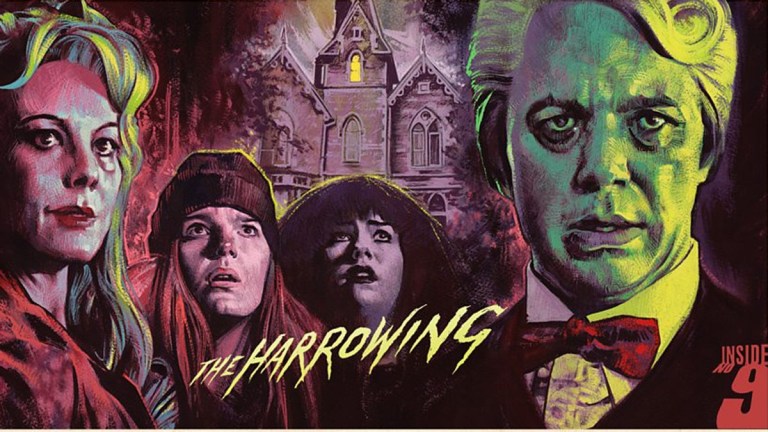
Warning: contains spoilers for Inside No. 9 ‘The Harrowing’
“It was ‘WTF!? Oh my God! I’m not going to sleep! Why did you do that to me?!’” The moment the credits rolled on Inside No. 9’s series one finale ‘The Harrowing’, director David Kerr was deluged with messages. “People were very responsive,” he laughs. “We’d gone for something bold that was properly horrible and would haunt them. There’s not much out there that scares a horror fan because they’ve seen it all so many times. That’s the challenge. You want to hit people with a visceral, palpable gut punch that they didn’t see coming.”
Job done. The final shot of 2014’s ‘The Harrowing’ is truly deserving of the episode’s title. A schoolgirl, stripped, bound to a chair, gagged and anesthetised, whimpers in terror as the filthy curtains surrounding a four-poster bed begin to part. One necrotised cloven foot touches the floor, followed by another. A contorted, emaciated figure emerges, naked but for a soiled nappy, with curling fingernails and clouded eyes in a grey pock-marked face. It staggers towards the helpless girl, hissing a single world with demonic glee: “Mischief”
Kerr describes the image as “pretty strong meat” and few would disagree, especially considering that the meat in question was paid for by a comedy budget. Reece Shearsmith and Steve Pemberton’s anthology Inside No. 9 has never fitted neatly inside either the stall of comedy or drama. It’s one, the other and both at the same time. “Unfortunately, there isn’t a channel that has a horror department in the same way as comedy,” says Kerr. “That’s what we need to get going!”
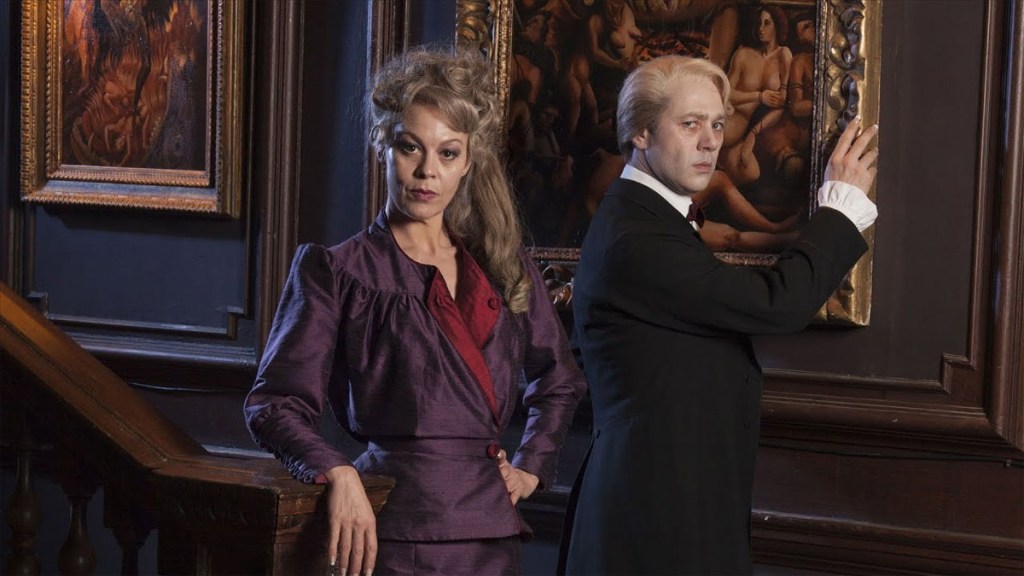
Kerr directed every episode of Inside No. 9’s first series: six half-hour films, each with a different setting, cast of characters, and tone. ‘The Harrowing’ is Shearsmith and Pemberton’s tribute to horror cinema classics, a specialist subject. Before starting work on the series, Kerr anticipated being schooled by the pair in obscure 1970s horror and rare Giallo movies they wanted to reference, but that wasn’t how it went. “’The Harrowing’ was very much a full-on genre film, and indebted to the Hammer tradition and the Amicus tradition of portmanteau horror, and though they have a tremendously deep knowledge of all that material – more so than me – Reece and Steve were actually very non-prescriptive.”
The script came to Kerr in a perfect state with plenty of detail, he remembers, but aside from some specific Vincent Price nods in costume and make-up, the creators were open to visual ideas – as far as the cash would stretch. “Always with Inside No. 9, budgetary challenges rear their head. You’re trying to make something that feels like a film, but you’re trying to do that on the budget of an episode of Mrs Brown’s Boys”.
It was clear there wouldn’t be the money for a full-body VFX transformation for the demonically possessed Andras who makes such an impression in the final scene. Like most limitations in Inside No. 9 though, it turned out to be a creative blessing, says Kerr.
Andras is the eldest of the three Moloch siblings, brother to the vampiric-looking Tabitha (Helen McCrory) and Hector (Reece Shearsmith). He lives in an upstairs room of their freezing Gothic mansion, kept tied to the bed and fed like a baby on milk formula and Rusks. Fifty years earlier, we’re told, Andras was possessed by mischief demon Castiel, an infernal spirit now in search of a new home – hence the anesthetised babysitter, Katy (Aimee-Ffion Edwards).
“You’re always wary of showing the monster, but we knew that we did want people to see Andras. A lot of the conversations ahead of the shoot were about what we could do with our limited pocket of money to make him properly scary, but in a way that you could still feel that he’s human. He’s right on the border between a poor, neglected sibling who’s just been left to stagnate in this room with a dirty nappy and untrimmed toenails. We wanted him to be just at the outer limit of the neglected human, but not to push him into a totally risible demon caricature state.”
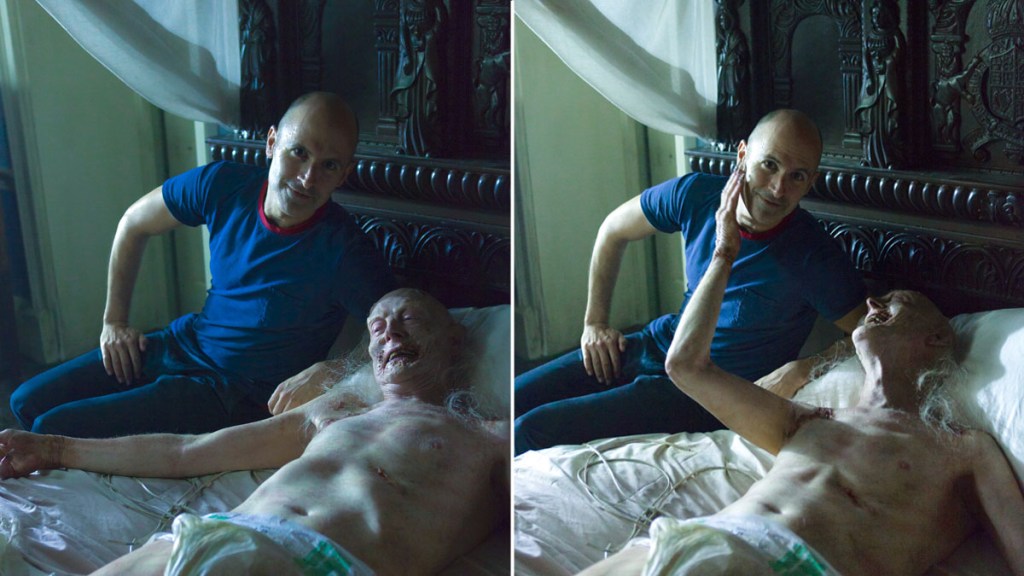
Casting Sean Buckley in the role was key to keeping a grip on the character’s pathos, says Kerr. He describes Buckley, who sadly passed away in 2016, as a hugely gifted physical performer. “He had a great physique and an amazing face, and he really understood the kind of contortions that would be useful for Andras when he was writhing and for his walk. The main thing was the physical tautness that he was going to be feeling when he’s writhing in the bed in chains. Sean just got it.”
As reference material for Andras’ look, Kerr and the team went to a range of sources: The Pale Man from Guillermo del Toro’s Pan’s Labyrinth, Dickensian ghosts and the Pee Pee Demon from Joss Whedon and David Greenwalt’s Angel. The character’s make-up was the work of Lisa Cavalli-Green, who brought in skilled prosthetics designer Kristyan Mallett to create Andras’ horrific set of teeth. “We went for details,” says Kerr. “Planning a shot, it was very much about half seeing him through that veil. As ever with horror and comedy, you’re just holding back the reveal. Again – testament to Reece and Steve – they didn’t give Andras tons of dialogue. Less was definitely more.”
The opposite applied to the episode’s Gothic location; in that case, more was definitely more. Kerr remembers his first look at the 19th century Highgate mansion that served as the Moloch house exterior (16 Broadlands Road, N6, if you’re planning a visit). “It was a real ‘we’ve got to use this’ moment. Reece would like to live there, incidentally, that’s going to be his home one day.”
For the interiors, it all came down to the staircase. Inspired by the grand staircases in films like The Others, The Orphanage and The Woman in Black, Kerr’s team went looking for similar. Another reference was more comic-horror. “For Reece and Steve, the characters of Tabitha and Hector felt a little bit like Addams Family characters. I found one of the original Charles Addams cartoons with a staircase in it and then found Langleybury and the staircase was almost identical. That was a real Eureka moment.”
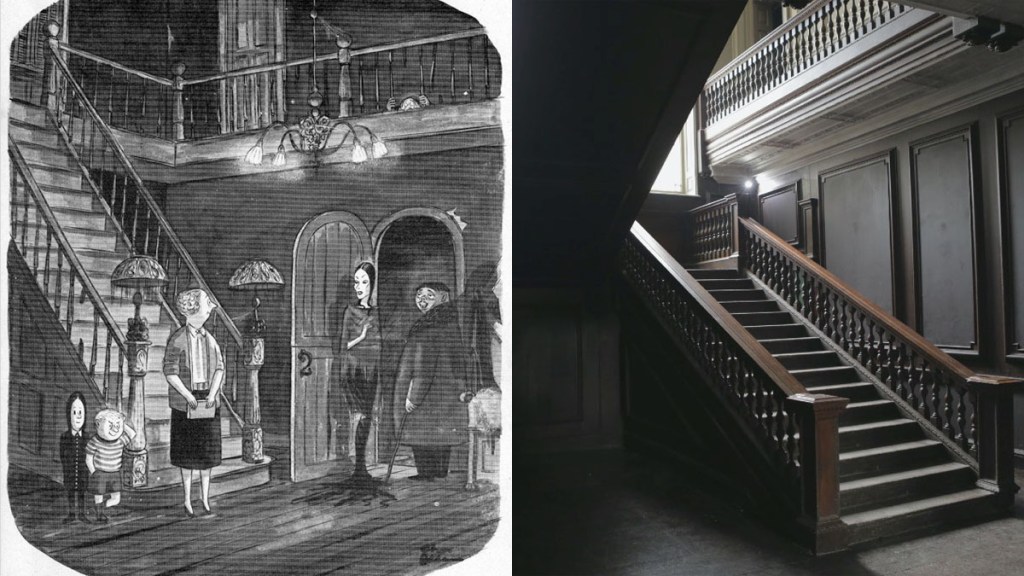
The interiors were filmed in Langleybury, near Watford, which has also been used in the filming of Harlots, a 2011 Great Expectations and feature film The Little Stranger. The atmospheric, dilapidated interior with a galleried area and a series of ante-rooms was perfect for Shearsmith and Pemberton’s script. “You just felt – what could be behind those closed doors?”
Taking viewers up to those closed doors were Steadicam shots by specialist operator Alf Tramontin, whose previous work includes the Harry Potter films and Alfonso Cuarón’s Gravity. Kerr aimed to achieve “a prowling point of view” and designed shots very specifically to draw the eye through the house and give the impression there were whole rooms and wings that were rarely used. John Carpenter’s Halloween was an inspiration for the choreography of those shots. “It’s all about the girls, Katy and Shell (Poppy Rush) creeping up the stairs and just not being able to quite see past the corner, putting the audience in their point of view in terms of what might be behind a door, or a covered piece of furniture beneath a dust sheet.” The dusts sheets covering the furniture fed into the unsettling idea that you’re not quite sure what lurks beneath, says Kerr, before adding with a laugh, “that was also so that we could just put any old crap underneath without having to rent a lot of expensive props!”
Custom props were made for the hellish pictures on display in the Moloch hall. Production designer Brian Sykes had reproductions made of 15th and 16th century paintings depicting the Harrowing of Hell. “That was tricky, because really you wanted a whole gallery of these things, just to feel they were everywhere, but the flip side of that is if Tabitha and Hector had this stunning art collection, maybe they wouldn’t live in such a ratty house. The fact they only have a few of those paintings makes you think ‘are they for real? Is this all a bit of a con?’ And that’s what you want the audience to be asking themselves.”
A crucial part of directing the audience’s feelings in the episode is the work of Inside No. 9 composer Christian Henson. “He’s so inventive and brilliant,” says Kerr. “None of those films sound alike from a score point of view.” For ‘The Harrowing,’ Henson drew inspiration from the Giallo vintage synthesizer used in the Goblin score for Dario Argento’s Suspiria, and once again, from Carpenter’s famous Halloween theme.
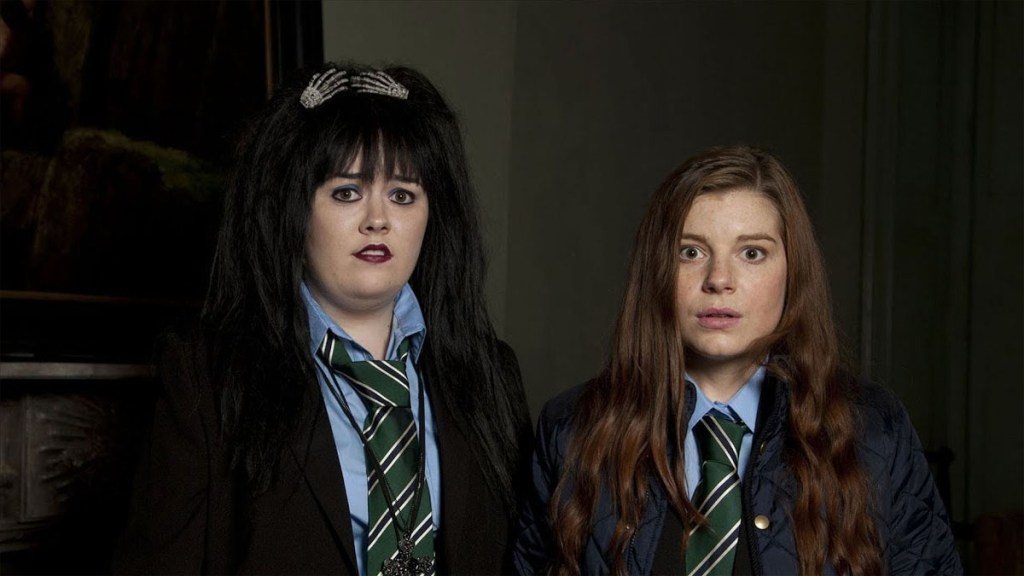
That’s a lot of horror talk for 30 minutes of television commissioned under a comedy banner. The comedy though, is very much there in ‘The Harrowing’, which begins as a fond pastiche of the kind of lurid characters found in Hammer Horror films such as Roger Corman’s Vincent Price-starring House of Usher. Kerr knew that guest star Helen McCrory had the colours to make Tabitha something special. “Helen just took to it and had that voice and poise. The character’s this sort of grande dame, larger than life.” McCrory and Shearsmith’s performances are expertly pitched to riff on the theatricality of those stars of vintage horror.
“So much of the film plays in a fairly camp register. You meet Hector and he’s Vincent Price-ish, a slightly campy eccentric. Tabitha is almost like a sort of Norma Desmond from Sunset Boulevard, shuttered in the chateau. They’re oddballs, and they’re funny and bicker like an old couple. By the time Hector pulls out the guitar and is singing Lord of the Dance, you’re thinking ‘this is bordering on ludicrous!’, and then it’s about how far can we push that comedy and turn the corner to something properly dark. The Lord of the Dance silliness takes your guard down, I hope, so that by the time Aimee-Ffion Edwards’ character is sitting there and Castiel in Andras’ body is advancing towards her, it’s properly horrifying, and you’re thinking ‘I didn’t see this coming’.
“They are twins, comedy and horror. They’re both the cinema of sensation, you’re trying to create a visceral reaction from people. Fear and laughter are proper physical reactions in people, rather than intellectual ponderings. You want to incite those reactions and you do that by getting ahead of the audience and not letting them get ahead of you. And that’s always been the genius of a script by Reece and Steve. That’s what they do.”
David Kerr’s festive film Roald & Beatrix: The Tail of the Curious Mouse will air this Christmas on Sky One and NOWTV.
Inside No. 9 is available to stream now on BBC iPlayer.
